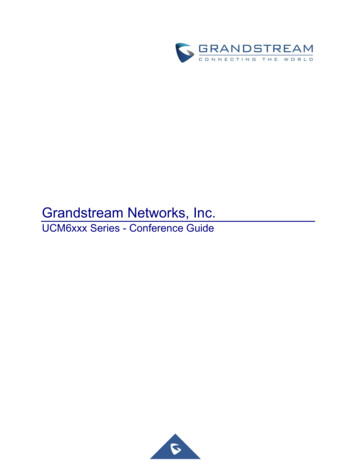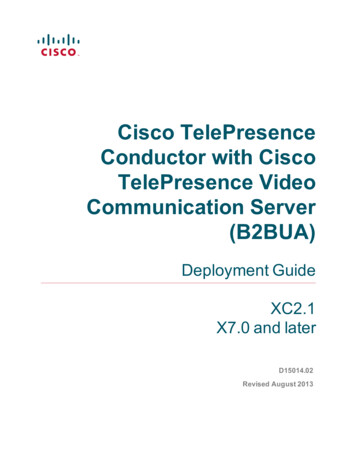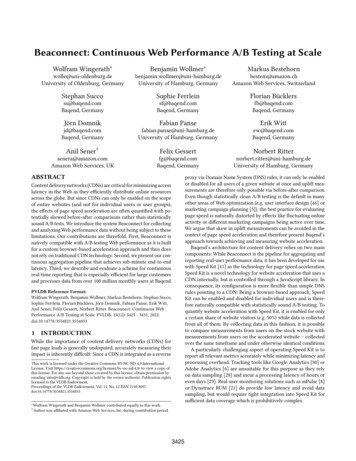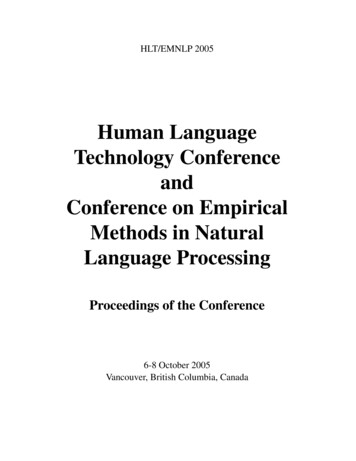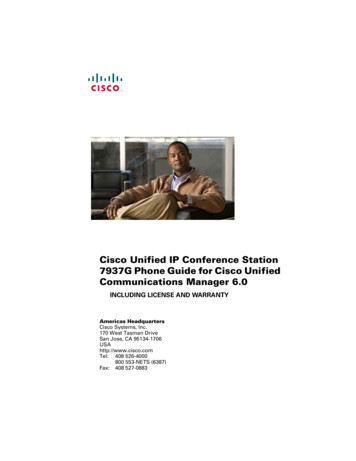
Transcription
CSICOPCONFERENCEControversies in Science and Fringe Science:From Animals and SETI to Quackery and SHCWe asked Lys Ann Shore, who writes frequently for our News and Comment section,to cover the 1987 conference of the Committee for the Scientific Investigation ofClaims of the Paranormal in Pasadena. She contributed these reports.INVESTIGATING controversialclaims in both science and fringescience was the theme of the 1987CSICOP conference in Pasadena, California. The meeting attracted a curious,attentive, and outspoken audience of 700to sessions held on Friday and Saturday,April 3 and 4. Although CSICOP is bestknown for its investigation of paranormalclaims, this conference highlighted acomplementary aspect of the committee'swork—the promotion of science as thebest approach to obtaining knowledgeabout the world.The issues examined covered astronomy, behavioral science, and medicine,focusing on the search for extraterrestrialintelligence, animal-language research,and controversial medical practices. Inaddition, concurrent sessions on Saturdayafternoon turned to areas of fringe scienceand the paranormal—astrology, spontaneous human combustion (SHC), andpsychic fraud. The high point of the conference came on Friday night, when thekeynote address by astronomer CarlSagan drew a crowd of 1,500 people.At the opening session on Fridaymorning, Caltech president Dr. MarvinGoldberger welcomed CSICOP to Pasadena. "Science is a peculiar business," hesaid, one in which effects and phenomenacan appear mysterious until understood.Be skeptical of new phenomena, he advised the audience; subject them to rigorous examination; and keep an open mind.Paul Kurtz, CSICOP founder andchairman, then briefly explained the6meeting's theme, pointing out that a scientific controversy can't be labeledpseudoscientific without examination."We can't claim to be the judge. Theentire scientific community has to dothat," he said. Kurtz introduced CSICOPExecutive Director Mark Plummer, whoemphasized the committee's growing international reach. The S K E P T I C A LINQUIRER, he said, now goes to readersin 52 countries; the conference itself drewpeople "from Vancouver to Mexico andfrom Boston to Florida." In fact CSICOPcan now be seen as a large, internationalconsumer protection organization, Plummer said, "making people skeptical aboutfraud." He urged, however, that the localskeptics groups exercise caution and prudence in their activities to avoid beingseen as vigilante groups.Saturday's schedule included an optional lunch hosted by magician JamesRandi. In an informal postprandial talk,interspersed with his well-known escapetricks, Randi spoke "not as a magicianbut as a founding member of CSICOP."He expressed concern about college students today, who are not always taughthow to examine evidence and form arational decision on the basis of the evidence.Randi also presented his annual BentSpoon Awards: a Media Award toABC-TV for airing "Out on a Limb,"Shirley MacLaine's odyssey into mysticism; a Funding Award (for the largestamount of money given for the silliestpurposes) to Jerry Collins for his 1.3THE SKEPTICAL INQUIRER, Vol.12
P A S A D E N A '87The Southern California Skepticsserved as local support for the conference,facilitating arrangements and providingthe many volunteers who helped the conference run smoothly. They also enlivenedthe banquet with a large self-propelledMylar UFO that rotated majestically asit sailed about the ballroom, bearing onits side the message, "Phil Klass, WhereAre You?"Keynoter Carl Sagan TakesUp 'Burden of Skepticism'are congratulated by Kurtz.million donation to TV evangelist OralRoberts; and a Performer Award totrance-channeler J. Z. Knight for herportrayal of the 35,000-year-old character"Ramtha."Mark Plummer then took the stagewith a fund-raising appeal, contrastingthe fees of paranormalists to those ofCSICOP: "A modest fee. for what weoffer," Plummer said.At the CSICOP Awards Banquet,held Saturday evening in the ballroomof the Pasadena Hilton, CSICOP FellowCarl Sagan received the In Praise ofReason Award. Caltech physicist andNobel laureate Murray Gell-Mann, alsoa CSICOP Fellow, was honored with theFrontiers of Science and TechnologyAward. Responsibility in Journalismawards were presented to three journalists: Los Angeles Times editorial writerLee Dembart. Texas radio talk-show hostEd Busch. and Australian journalistMichael Willesee.Entertainment at the banquet wasprovided by comedians magicians Penn& Teller, who staged a spellbinding showof New Wave magic and comedy, with alittle help from "assistant" Murray GellMann.Fall 1987EVERY AREA of life, from buyinga used car to evaluating Star Warsdefense schemes, calls for "an exquisitebalance between two conflicting needs:the most skeptical scrutiny of all hypotheses . . . and openness to new ideas,"said astronomer Carl Sagan in his keynote address. (See p. 38, this issue)Speaking to an attentive and appreciativecrowd in the elaborately decorated Auditorium Theater of the Pasadena Center,Sagan ranged from TV commercials totrance-channeling, extraterrestrial intelligence, and Star Wars to show the needfor skepticism in daily life. Just as manytelevision commercials betray "a real contempt for the intelligence of the listeningaudience," so do U.S. arguments fornuclear-weapons testing. There are peoplein government "who think Americans willbuy any English sentence as long as itparses." Sagan said.Sagan views skepticism and opennessto new concepts as complementary attitudes. "If you're only skeptical, no newideas make it through to you," he pointedout. But if you're altogether open andhave no skeptical sense you won't be ableto evaluate them. Sagan praised the scientific ethic of rigorous criticism of newideas.Why isn't the American public moreskeptical of claims by corporations and7
CSICOPCONFERENCEareas, it helps to keep in mind how science operates: Science demands independent confirmation of results and thewillingness to wait until the evidence isin before drawing a conclusion. "It's okaynot to know," Sagan said.Medical ControversiesGell-Mann receives Frontiers of ScienceAward from James Alcock.government officials—not to mentiontrance-channelers and other proponentsof the paranormal? Part of the answerlies in the cruelty of truth, Sagan believes."We may find delusion more consoling."for example, when we're offered the opportunity to communicate with lovedones who have died. But when we recognize we're vulnerable because of ourown desires, we must be more on guardthan ever. Sagan maintained.But the attraction of illusion isn'tsolely responsible for people's credulity."Skepticism is dangerous," Sagan said."That's exactly its function in my view."Children taught to be skeptical might notstop with TV commercials: instead, theymight start challenging accepted ideas andinstitutions.Recalling that afternoon's sessions onthe search for extraterrestrial intelligence(SETI) and animal language. Saganpointed out the predispositions that lieas undercurrents to these debates. Forexample, both issues involve the belief ofhumans in their own uniqueness—the"anti-Copernican conceit." As soon as wefind extraterrestrial intelligence, "the lastremnant of that conceit is gone." In evaluating claims made in these controversial8Standing in front of a "Quackbusters"logo, moderator Wallace Sampson, M.D.,started the "Medical Controversies" session by emphasizing the huge volume ofpseudoscientific medical claims facingCSICOP's Paranormal Health ClaimsSubcommittee: "Not everyone sees aUFO or has a psychic experience, buteveryone gets ill." He pointed to theloaded terminology of alternative medicine—"false dichotomies" like orthodox/unorthodox, traditional, untraditional,toxic, nontoxic, reductionist, holistic."Propaganda words," he called them.The session began with a statementby Dr. Leonard Savage, representing theAmerican Chiropractic Association.Shortly before the session began, theACA requested time to comment on"Chiropractic Medicine," by WilliamJarvis, the first scheduled talk on themorning's program. Commenting that hehad asked to respond to Jarvis's talkrather than precede it. Savage went onto emphasize the accreditation of chiropractic colleges and the respectability of"mainstream" chiropractic medicine.Chiropractors don't need outsiders tellingthem how to run their profession, he said:"What's needed is not hostility, arrogance, or conflict, but to all work together for the good of the patient."Jarvis. a professor of health educationat Loma Linda University who wrote hisdoctoral dissertation on chiropractic,described chiropractic as "not so muchparanormal as nonscientific or antiscientific." He traced its conceptualTHE SKEPTICAL INQUIRER. Vol. 12
PASADENA '87origins to nineteenth-century ideas ofvitalism and said its historical beginningsunder the aegis of D. D. Palmer fit thedictionary definition of a medical cult.Jarvis discussed the current rift withinthe chiropractic profession between"straights" (those who limit their practiceto spinal manipulation) and "mixers"(those who use other therapies in additionto manipulation). "I believe it's a mistaketo view chiropractic monolithically," hesaid.This failure to establish criteria ofpractice is the greatest flaw of the chiropractic profession, Jarvis believes. Hepointed out that chiropractic does notshow up well when evaluated for consistency of diagnosis. In response toSavage, Jarvis said, "1 disagree completely with the idea that people fromoutside the profession shouldn't look intochiropractic. That's the nature of thescientific method." (See also Jarvis's article on chiropractic in this issue.)Then philosopher Austen G. Clark,an assistant professor at the Universityof Tulsa, examined two premises and twoconclusions that underlie the concept ofholistic medicine. The premises are thatall diseases are caused by mental statesand that traditional medicine takes adualistic approach to treatment, separating mind from body. Proponents ofholism thus conclude that traditionalmedicine is inadequate to treat psychosomatic disease (in their view, nearly alldisease) and that holistic medicine is theappropriate approach to treatment.How many types of medical quacksare out there? Jerry P. Lewis, M.D., ofthe University of California, Sacramento,recognizes three: dumb, deluded, and dishonest. He defines them as follows: adumb quack is a simple person whothinks he's found the answer; a deludedquack is someone who is qualified butbecomes enamored of a particular un-Fall 1987proved treatment; and a dishonest quackis someone who promotes a treatmentthat he knows to be ineffective.Lewis said quacks are recognizableby their use of lay publications as authorities and by their attacks on medicine,their endorsement of a single therapy, andtheir focus on subjective evaluations ofthe effectiveness of a therapy. Presentinga rogues' gallery of cancer quackery, including bizarre machines and wacky diets,Lewis recommended that doctors discussquack treatments "up front" with theirpatients: "We should encourage patientsto take responsibility for their own care,and we should be prepared to answer theclaims of quacks."Hypnosis, Astrology, and ' S H CThe choice wasn't easy: To hear abouthypnosis or spontaneous human combustion? To investigate psychic fraud orastrology? But the audience had to chooseone from each pair of Saturday afternoonconcurrent sessions. The sessions were afirst in CS1COP conference programming, an effort to pack as much information as possible into the two-day conference.Spontaneous Human Combustion: JoeNickell, a technical writing instructor atthe University of Kentucky, Lexington,effectively debunked the gruesome notionof spontaneous human combustion(SHC), which first gained notoriety inthe early 1950s. In fact, as Nickell pointedout, the earliest reported cases date fromthe eighteenth century, and the termspontaneous human combustion wascoined in the nineteenth. The majority ofcases, Nickell said, involve elderlywomen, living alone, who had a historyof alcoholism. (See Nickell's article, "Incredible Cremations," SI, Summer 1987.)Reviewing case histories, Nickell9
CSICOPCONFERENCEGell-Mann laughs at Sagan remark at banquet.pointed out several other similaritiesamong them, including the report of aresidual grease spot; the generally incomplete combustion of the body; and thecharring—but not burning—of the roomin which the combustion occurs. Thebasic fallacy in SHC is the notion thatextraordinary heat is required to reducea human body to ashes (as in a crematorium), and of course this would haveto have a catastrophic effect on the surroundings. But in the majority of reported cases, several hours were availablefor the body to burn at a much lowertemperature. If combustion occurs slowly,the clothing and the body provide "allthe heat and fuel you need."After careful investigation, Nickellconcluded that SHC does not exist. Allknown cases can be explained by "gruesome but normal" means. "There's noneed to invoke the paranormal."Hypnosis: "Hypnosis is both more dramatic and less mysterious than most people think," said Joseph Barber, of theDepartment of Psychiatry at the University of California, Los Angeles. He defined10hypnotism as a condition, usually inducedby a hypnotist, that creates in the subjecta marked susceptibility to suggestion andhas the capacity to alter perception.Hypnosis was once seen as somethingparanormal, magical, or mystical, butresearch in recent decades has shown thatit is amenable to scientific investigation.In Barber's view, "what's important abouthypnosis isn't that you can create suchphenomena but rather that you can createso many of them so well, in so short aperiod of time. And you can do it systematically."The neurophysiology of hypnosis isnot yet understood. Barber said. He discussed the widely accepted "neo-dissociation" theory of Ernest Hilgard: that hypnosis is a psychological process thatallows a person to have multiple simultaneous levels of consciousness.Although Barber's audience may havebeen expecting him to perform a demonstration, he didn't—and explained hisreasons. "The real interest of hypnosis isinternal," he said, comparing a publicdemonstration of hypnosis to demonstrating dreaming by bringing someoneTHE SKEPTICAL INQUIRER, Vol. 12
P A S A D E N A '87up on stage to go to sleep. "You wouldn'tbe able to see them doing the work ofhypnosis."What about stage acts of hypnosis?"Stage hypnosis is not hypnosis," saidBarber flatly. "What stage hypnosis doesis demonstrate how peculiarly people willbehave if given a good excuse."Barber dismissed forensic hypnosis,pointing out that "there is very littleevidence that hypnosis can improvememory. The hypnotized person is likelyto come up with an additional piece ofinformation, but the information is aptto be wrong—and yet the person willmost likely have great confidence in theaccuracy of the recollection."Astrology: "Are clients of astrologerssatisfied because astrology works, or forother reasons?" asked Ivan Kelly, a psychology professor at the University ofS a s k a t c h e w a n a n d c h a i r m a n ofCSICOP's Astrology Subcommittee. Ifyou ask astrologers for evidence of theirsuccess, they'll usually cite testimonials."Birth charts are nonjudgmental, resultsare nonfalsifiable, and most astrologersare very nice people." Kelly pointed out.Thus astrology may very well work, if by"work" you mean "be helpful." and itssuccess would owe more to "personalvalidation" than to astrological theory.Kelly listed 20 nonastrological factorsthat enter into the "personal validation"of astrology, including: Barnum statements (general statements interpretedspecifically by individuals), placebo effects, hindsight bias, cold-reading effects,rapport effects, social desirability effects,and projection effects (finding meaningwhere none exists).Comparing astrology to phrenology.Kelly pointed out several similarities.Both focus on personal development andpersonal characteristics; both are basedon theories expressed authoritatively al-Fall 1987Randi, Sagan share an after-banquetmoment.though lacking experimental evidence. Inboth cases, clients could see for themselves that the system worked. And laterpractitioners of phrenology, like today'sastrologers, tended to view the system asspiritual rather than scientific. Yet, "inspite of everything, phrenology waswrong." said Kelly. "So why shouldn'twe conclude for the same reasons thatastrology is wrong?"Psychic Fraud: This session turned outto be far more narrow in scope. DetectivePatrick Riley of the Los Angeles PoliceDepartment's bunco-forgery squad toldof LAPD's efforts to combat fortunetelling shops. "Fronts for swindle." hecalled them. The fortune tellers are typically women, often from families of fortune tellers. They set up temporarystore-front shops, lure in the gullible, findways to make off with their money, anddisappear. A typical gambit is to appearto withdraw a foreign object from an eggor a tomato and thereby convince thevictims that they are cursed. Money canII
CSICOPCONFERENCEwithdraw the curse. Another is to persuade the innocent that their money iscursed. If they bring it in, the fortuneteller will be all too willing to exchangethe afflicted currency for uncursed bills.The money is exchanged, but the wad ofbills returned contains only shreddedpaper in the center. "It's the oldest scamin the world."Riley lamented the loss of the LosAngeles fortune-telling ordinance passedin the 1920s, which provided some lawenforcement leeway. The State SupremeCourt threw it out in 1985. The fortunetellers are now harder to catch than ever,he said. He called for a return to thewisdom of the former law, "that no onecan predict the future."Extraterrestrial Intelligence:What Are the Probabilities?Astronomer Frank Drake, dean ofnatural sciences at the University of California, Santa Cruz, led off the openingsession of the conference by asking whythe search for extraterrestrial intelligence(SETI) should be on the program. "Thoseof us involved know the search for extraterrestrial intelligence is mainline sciencethat needs no second-guessing about itsworthwhileness," he said. But Drakeacknowledged that SETI is a good example of a "truly scientific" activity thatwhen improperly presented can look likepseudoscience.SETI follows scientific methodology,Drake pointed out. "We assume thesimplest explanation, even if it doesn'tseem that way." The best answer to thequestion of why anyone would thinkthere could be life in outer space issimply, "Why not?" "The developmentof life required nothing special," Drakesaid, "no freak phenomenon or one-timeevent." It follows that there should be "a12great deal of life out there in the universe."How difficult will it be to find extraterrestrial life, if it does exist? "In SETI,you can't know how hard the search isuntil you've succeeded," Drake said,pointing out that there is—and shouldbe—controversy over how the searchshould be conducted and what kinds ofevidence should be sought. "But thereshouldn't be, and isn't, controversy overwhether such life is likely to exist," hesaid firmly.Drake mentioned an argument thathas been used to challenge his view ofthe prevalence of extraterrestrial life: thenotion of colonization. "If only one civilization chooses to colonize, by some calculations they should have come to Earthby now; so, since they haven't, we mustbe alone." Drake offered several counterarguments to this view. First, citing CarlSagan, he suggested that colonizationcould follow a random-walk pattern:"They're not here yet, but maybe soon."Second, there could be impediments tospace travel that we don't yet know of(the "iron basketball" argument). Third,extraterrestrial visitors might already behere, unknown to us. Fourth—the viewthat Drake himself espouses—"Maybecolonization isn't something an intelligentcivilization would do, in terms of a cost/benefit analysis that would balance theenergy cost of colonization against thecost of providing a good life for folks athome."A somewhat different view was expressed by astronomer Robert Rood ofthe University of Virginia, Charlottesville,who has debated Drake before. Althoughhe acknowledged that "you can't proveextraterrestrial civilizations don't exist,"Rood compared them to unicorns:"They're both very plausible animals."Referring to the medieval legend thatunicorns could only be captured byT H E SKEPTICAL INQUIRER, Vol.12
P A S A D E N A '87SETI panelists Tarter, Drake. Hibbs, Lee Nisbet (CSICOP), and Roodtake questions from audience.virgins. Rood argued, "If you put a virginout, wait, and no unicorn shows up, allyou can conclude is that unicorns don'tlike virgins. So you've learned somethingabout the habits of unicorns, but nothingabout their existence. What was in it forthe unicorn? I ask the same questionabout extraterrestrial civilizations."Rood believes that human beings willfind space a technologically fruitful, andprofitable, environment. "We won't beable to grow much more on Earth, butin space we can expand by factors ofbillions." Energy is abundant in space,he pointed out. Furthermore, space is abenign environment for technology, eventhough it's hostile to life. The surface ofa planet, he said, is an extremely hostileenvironment to technology.It will prove easier to adapt life formsto space. Rood said, than to adapt technology to a planetary surface. Accordingto a unit of measurement that Roodhelped devise— total wattage intercepted:terrestrial (TWIT) Earth today is "amilli-TWIT society, whereas in space wecould be a mega-TWIT society just bycontrolling one asteroid." In Rood's view.Fall 1987it's "almost inevitable" that extraterrestrial civilizations would go as far as spacestations. Whether they would continuetheir penetration of space to colonizeother planets, however, is another question. "Using Drake's figures, out of 40million civilizations, if just one hadcolonized, they would have been here atthe time of the dinosaurs," Rood said."So perhaps we could be a fluke."Research astronomer Jill Tarter of theSETI Institute at the University of California, Berkeley, in the past ten yearshas done more observations in the SETIprogram than anyone else. She said SETIisn't looking for unicorns. "We're lookingfor something that we know very wellexists: evidence of technology like theevidence that our technology itself produces." The goal of the SETI programfunded by the National Aeronautics andSpace Administration (NASA) is tosearch for signs of extraterrestrial life byusing the larger radio telescopes to searchfor radio signals.Tarter compared SETI to "a nine-plusdimensional haystack in which you'researching for the needle." The dimensions13
CSICOPAnimal-language panelists Rosenthal, Hyman, Hovelmann,Sebeok.that must be searched through include:three spatial dimensions: time: frequency;polarization; transmitted power; bandwidth; and modulation.In 27 years of searching. 48 searcheshave been made from seven countries,mostly in radio wavelengths. These represent tens of thousands of hours of observations. Tarter said. Yet "none of thishas found anything that is reproducibleor believable."The NASA program is one of severalthat are currently under way. Accordingto Tarter, NASA's approach to the SETIproblem involves:1. Large-scale spectrum analyzers thatcan handle tens of millions of channels.2. A bimodal strategy of all-sky observations and selected solar-type stars.3. Automated detection and recognition of astrophysical signals, with anautomated check for interfering signals,that can search two polarizations simultaneously.Tarter described the current technology for the SETI program as "nearoptimum." This is a good reason, she14andsaid, for the search to be pursued now.She believes an even more potent argument is that increasing radio frequencyinterference is making ground-basedsearches increasingly more difficult toperform.As evidence of the SETI program'scapabilities. Tarter noted that it hasalready detected a signal from more than3 billion miles away. Instead of an extraterrestrial signal, however, the find turnedout to be "our most extraterrestrial projection"— Pioneer 10.Animal Language:Fact or Illusion?NO SESSION at the conference provoked more discussion than thesymposium on animal language. ThomasSebeok. professor of linguistics at IndianaUniversity, Bloomington, began by expressing disappointment that none of theproponents of animal language who hadbeen invited to participate in the sessionhad accepted.Sebeok pointed out that the conceptT H E SKEPTICAL INQUIRER. Vol. 12
PASADENA '87of animal language covers a spectrumranging from "generally accepted to lessaccepted." Communication is fundamental to animal life, and animals communicate perfectly well nonverbally. Toclarify discussion, Sebeok distinguished"communication," which has alwaysexisted, from "language," which humansdeveloped about 3 million years ago, and"speech," which "exapted" from languageabout 100,000 years ago. Why did it takeso long for speech to come out of language? Speech involves the intersectionof two different capacities: first, the vocalcords and speech structure;, second, hearing. "That this is not perfect is obviousfrom the fact that most people don'tunderstand what other people are saying,and the truth of that will be seen in thequestion-and-answer session," Sebeokquipped.Sebeok himself first became interestedin claims of animal speech when he wasasked to write a review of the literatureon the subject. After reading the literatureand visiting all the laboratories thatwould permit him to visit, he came tothe conclusion that the results were notscientifically valid: "They were not reproducible." Sebeok noted, by the way, that"many labs will tell you the animals won'tperform when you're there"—a claim hefelt would sound familiar to the CSICOPaudience.Criticism from himself and others"caused a storm" in the field of animallanguage research, Sebeok said. "Someof the major players simply announcedthey had quit the field." Federal fundingfor animal-language research dried up,he said, and reputable journals stoppedpublishing articles on it "and even, regrettably, have stopped refereeing them."Recently, however, animal-languageresearch has shown signs of resurfacingunder a new name: "animal intelligence."Sebeok mentioned a new series from aFall 1987major university press on "animal intelligence." "The first title in the series is ApeLanguage" he said. Sebeok calls termslike animal intelligence "weasel words.""If there's one word that's slipperier eventhan language, it's intelligence," hesays.Calling the debate over the definitionof "language" as applied to animallanguage research "largely futile," GerdHovelmann of the University of Marburg,West Germany, compared today's animallanguage research with past efforts. Henoted that contemporary ape-languageresearch is "almost entirely an Americanphenomenon" and can be traced to testsof the linguistic abilities of domesticanimals—pigs, horses, donkeys, anddogs—that were conducted between 1900and 1933. When early experiments arecompared with more recent experiments,Hovelmann said, the comparison showsthat the early tests were almost whollyuncontrolled. "Today's methods arehardly superior to those applied in theold research," he said. "Many of the samefallacies still exist."Reviewing the notorious Clever Hanscase, Hovelmann explained the "CleverHans fallacy": regarding the animal as amessage source rather than as a reflectionof a message sent by the human involved.Ape-language researchers claim thatClever Hans effects have been ruled out,at least in some experiments. But in fact,Hovelmann said, none even comes closeto doing so. Ruling out Clever Hanseffects would mean complete isolation ofthe animal from any perception or contact with the researcher. Researchers alsoclaim that they control the verbal andnonverbal signals they transmit to theanimals. However, "these signals arealmost impossible to control voluntarily,"said Hovelmann.Further parallels between early andcontemporary research include experi-15
CSICOPCONFERENCEmenter expectancy effects; shortcomingsin data recording, selection, and reduction; immunizing strategies, including an"inexhaustible" variety of excuses andrationalizations.The final speaker of the session, socialpsychologist Robert Rosenthal of Harvard University, described himself as onewho "studies the behavior of those whostudy behavior." The problems thatplague animal-language research, he said,are the same problems that affect thework of all those who study behavior.Rosenthal identified two classes ofexperimeter effects in behavioral research:those that affect the subject, and thosethat don't. For example, the interactionbetween the experimenter and the subjectwill influence how the subject performs.Experimenter effects with no direct effecton the subject nonetheless affect the outcome of the experiment. For example,"observer effects" influence how the experimenter views the experiment; theytend to "favor the theory of the theoretician," Rosenthal said. "Interpreter effects" come into play as the experimenterendeavors to understand the data obtained.To avoid such effects as far as possible, Rosenthal emphasized the importance of running behavioral experimentsblind and even double-blind. Becauseexperimenter effects can be very subtle,it's not realistic for experimenters to believe or claim—as in the case of someanimal-language researchers, as Hovelmann had pointed out—that they cancontrol the signals they send to theirexperimental subjects.The question period following thesetalks extended the range of discussioneven further, to dolphins and even toplants. Responding to a question aboutdolphin research being conducted inHawaii, Sebeok replied that this also is"open to the Clever Hans effect." Asked16about the relative intelligence of variousspecies, he said flatly: "There's no way tocompare intelligence. The no
"Chiropractic Medicine," by William Jarvis, the first scheduled talk on the morning's program. Commenting that he had asked to respond to Jarvis's talk rather than precede it. Savage went on to emphasize the accreditation of chiro practic colleges and the respectability of "mainstream" chiropractic medicine.



